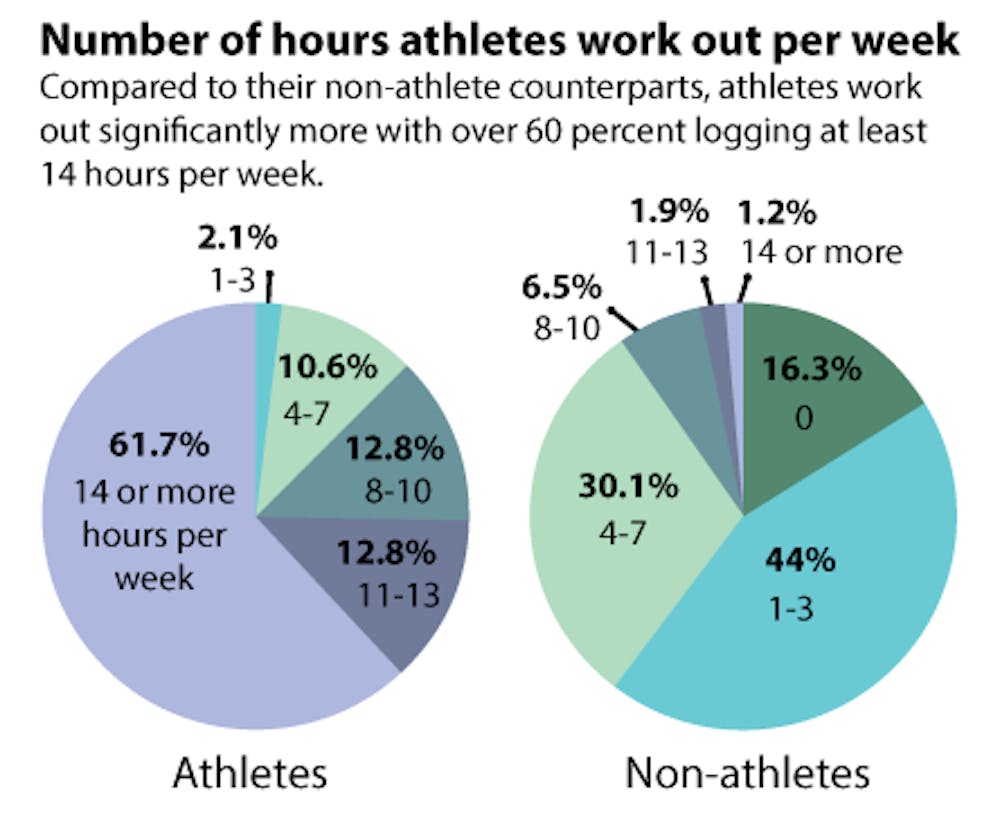The Herald’s fall poll found that 14.7 percent of students do not exercise, 39.5 percent exercise for one to three hours per week and 28.1 percent exercise for four to seven hours per week. Fewer students exercised more than that, with 7.2 percent exercising for eight to 10 hours per week, 3 percent exercising for 11 to 13 hours per week and 7.5 percent exercising for 14 or more hours per week.
Every week, adults should participate in 150 minutes of moderate activity, 75 minutes of vigorous activity or a combination of the two, according to recommendations from the U.S. Department of Health and Human Services’ Office of Disease Prevention and Health Promotion. “Doing more will lead to even greater health benefits,” according to ODPHP.
But most recommendations give no upper limit, said Jessica Unick, assistant research professor of psychiatry and human behavior. “There are no clear-cut guidelines on what is too much exercise,” she said.
“Obviously if you (exercise) too intensely as well as in high frequency, there are potential muscle-skeletal injuries along with accidental injuries,” said Simin Liu, professor of epidemiology and medicine. “But aside from that I really see a lot of benefit.”
At the 2014 Winter Olympics in Sochi, Russia, Ty Walker ’19 bruised the bone in her heel on the second day of training for slopestyle snowboarding. “They had to inject my foot with novocaine so I could compete,” she said. “I couldn’t feel from my shin down.”
She tore a ligament in her knee earlier this year and spent the summer rehabilitating. In past seasons of snowboarding, she has also had concussions, sprained her neck and rotated a vertebrae.
Walker began snowboarding when she was seven or eight and continued to practice the sport through high school, which she completed online because her sport required so much travel. At Brown, she exercises 10 to 15 hours a week, doing circuit training and weight training as well as running 25 miles every week.
Exercising so much while in school does have its downsides for Walker. “I’ll skip out on social things to go train,” Walker said, adding, “Now that I have to go to classes and sit and do my work, I feel so much more sore.”
Walker is hoping to compete in the 2018 Winter Olympics in PyeongChang, South Korea. “A big part of it is definitely trying to stay strong and fit for my sport,” she said.
The differences between appropriate and excessive amounts of exercise are injury, acting against a doctor’s advice or spending less time with family and friends, Unick said. “It’s more the motivations behind the exercise,” she added.
Important questions about extreme exercise have not yet been answered. “I don’t think there’s a problem of overexercise,” Unick said.
“There’s a very small number of people outside of the athletes who work out at the same level,” Walker said. When people see her working out, they assume she is on a varsity team. When they find out she is not a varsity athlete, “They don’t really understand what to ask next,” she said.
Studies have also shown that among younger adults, 40 percent self-report meeting the exercise recommendations, but only 10 percent meet the guidelines by objective measures of activity, Unick said. When self-reporting, individuals often overestimate the time they spend exercising.
Of the students who reported exercising for 14 or more hours per week, 85.3 percent are on a varsity sports team, according to The Herald’s poll.
Keenae Tiersma ’19, a member of the women’s crew team, said she spends about 21 hours per week exercising. Practicing five or six days a week depending on the time of year, she finds that her whole schedule is determined by practice. “I can’t really go out and party except for one day a week because we just have practice every single day, or we have morning practice. You definitely have to prioritize what you want,” she said.
But Tiersma said the commitment is worth it. “The team really pushes you. Seeing all of your teammates working harder than you, or just as hard as you, really motivates me,” she said. “You want to make your team proud and do well.”
Jake Miller ’18 and Max Gustafson ’19, both varsity lacrosse players, said they practice 15 hours per week during the season and six hours per week in the off season. But Miller said the practice time is not all-consuming.
“They do a good job offering tutors. But the time commitment? I don’t think it’s that much that it really impedes the schoolwork,” he said. “I have plenty of time to do all my work. It’s easy to manage.”
Gustafson said his desire to win and his relationships with his teammates are his biggest motivations. As for scheduling, he said the largest constraints are in the 72 hours before games, in which “we can’t really do anything socially.” For his academics, he said tutors are available for help if needed.





